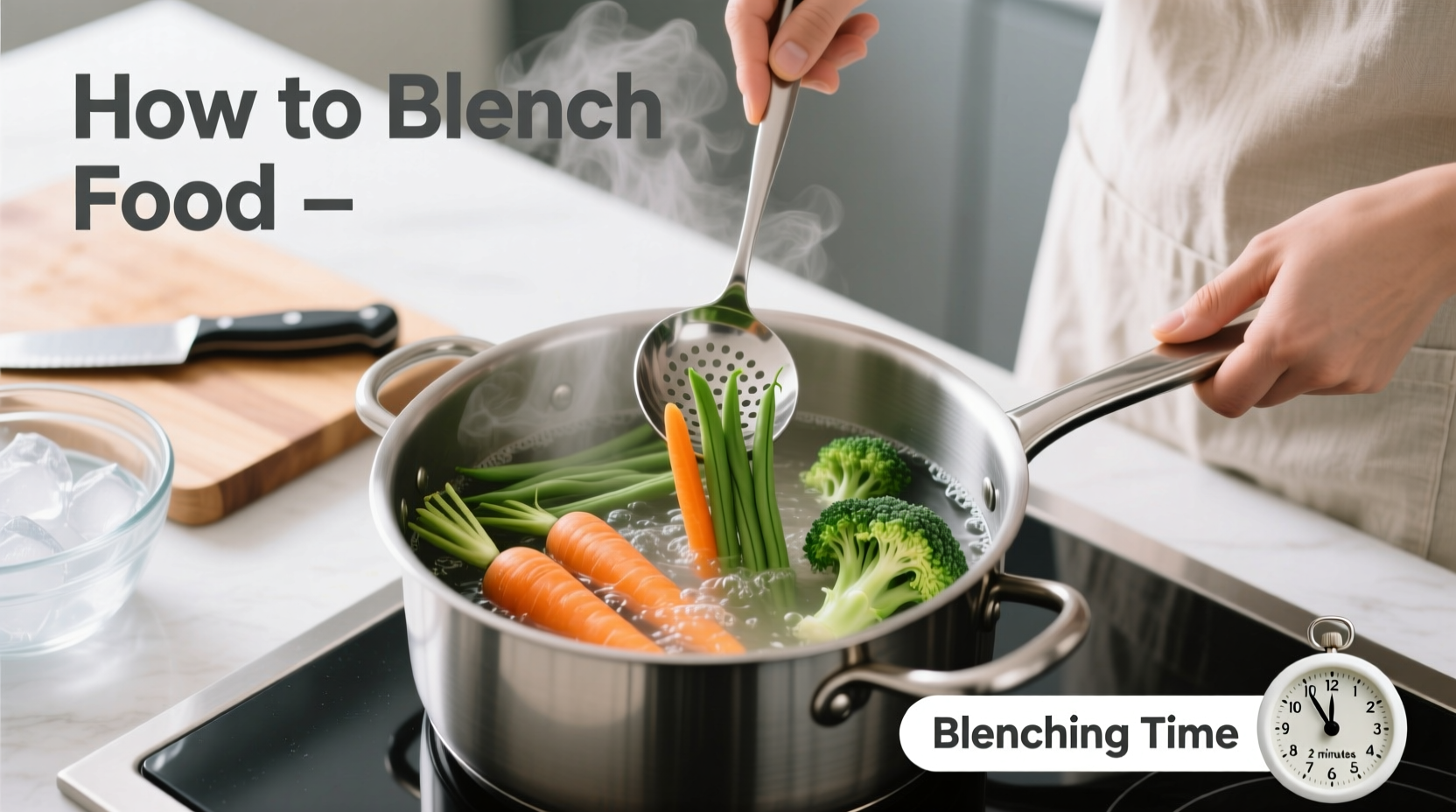Blanching isn't just another cooking step—it's your secret weapon for maintaining peak vegetable quality. Whether you're prepping for meal prep, preserving summer harvests, or elevating restaurant-style dishes, proper blanching makes all the difference. Forget soggy greens or faded colors; this guide delivers precise timing, professional tricks, and science-backed methods that guarantee crisp-tender results every time.
The Science Behind Successful Blanching
Blanching works through controlled heat exposure that deactivates enzymes responsible for spoilage while preserving texture. When vegetables are harvested, natural enzymes continue breaking down chlorophyll (causing color loss) and cell structures (leading to mushiness). The USDA's National Center for Home Food Preservation confirms that proper blanching destroys these enzymes, extending shelf life by up to 8 months when freezing. The critical window? Just 2-5 minutes in boiling water followed by immediate cooling.

When Blanching Is Essential (And When It's Not)
Not all produce benefits equally from blanching. Understanding context boundaries prevents wasted effort:
| Best Candidates | Questionable Candidates | Avoid Blanching |
|---|---|---|
| Green beans | Carrots (thin slices) | Leafy greens (spinach, kale) |
| Broccoli florets | Cauliflower | Tomatoes for sauces |
| Asparagus | Peas | Onions |
| Brussels sprouts | Corn kernels | Peppers for roasting |
According to the FDA's Food Code, vegetables with high enzyme activity like beans and broccoli require blanching before freezing to prevent quality degradation. Dense vegetables like carrots only need blanching when freezing whole; thin slices can go straight to cooking. Leafy greens lose too much texture during the process—better to wilt them directly in your dish.
Step-by-Step Blanching Protocol
Follow this professional chef-tested sequence for flawless results:
- Prep Work: Wash and trim vegetables uniformly. Smaller pieces cook faster—aim for consistent sizes.
- Water Ratio: Use 1 gallon of water per pound of produce. Add 1-2 tablespoons salt per gallon (not for flavor—raises boiling point).
- Boiling Phase: Bring water to rolling boil. Submerge vegetables in batches (overcrowding drops temperature).
- Timing: Start timer immediately upon immersion. Refer to official USDA blanching times below.
- Ice Bath: Transfer instantly to ice water (1 part ice to 2 parts water). Cool completely—usually 2x boiling time.
- Drying: Pat thoroughly with clean towels before storing or cooking further.
Vegetable-Specific Blanching Times
These USDA-recommended durations prevent under or over-processing:
| Vegetable | Cut Size | Boiling Time | Ice Bath Time |
|---|---|---|---|
| Green beans | Whole | 3 minutes | 6 minutes |
| Broccoli | Florets | 2 minutes | 4 minutes |
| Asparagus | 1-inch pieces | 2 minutes | 4 minutes |
| Carrots | ¼-inch slices | 3 minutes | 6 minutes |
| Brussels sprouts | Whole | 4 minutes | 8 minutes |
Source: USDA National Agricultural Library
Avoid These 4 Costly Mistakes
Even experienced home cooks trip up on these blanching pitfalls:
- Skipping the ice bath: Residual heat continues cooking—your crisp veggies become mush within minutes. Always use sufficient ice to drop temperature below 40°F rapidly.
- Overcrowding the pot: Adding too much produce at once lowers water temperature below boiling. The American Culinary Federation recommends processing no more than 1 pound per gallon of water.
- Incorrect timing: Under-blanching actually accelerates enzyme activity. Over-blanching leaches nutrients—stick to USDA guidelines.
- Insufficient drying: Water promotes ice crystals when freezing. Pat completely with lint-free towels before storage.
Advanced Applications Beyond Basic Blanching
Professional kitchens leverage blanching for multiple purposes:
- Peel removal: Blanch tomatoes or peaches for 30 seconds, then transfer to ice bath—skins slip off effortlessly.
- Bitterness reduction: Blanch bitter greens like kale or dandelion for 1 minute to mellow flavors while retaining nutrients.
- Color enhancement: Chefs blanch green vegetables before sautéing to intensify chlorophyll—try it with asparagus before finishing in butter.
- Freezing prep: Properly blanched vegetables maintain 90%+ nutrient retention after 6 months frozen, versus 50% for unblanched (per Journal of Food Science).
Storage Guidelines After Blanching
Maximize shelf life with these evidence-based methods:
- Refrigeration: Store in airtight containers for up to 5 days. Line containers with paper towels to absorb moisture.
- Freezing: Spread blanched, dried vegetables in single layer on baking sheet before transferring to freezer bags. Removes air pockets that cause freezer burn.
- Vacuum sealing: Extends frozen storage to 12-18 months. Works best with completely dry produce.
- Immediate use: For salads or cold dishes, keep in ice water bath up to 1 hour before serving to maintain crispness.
Troubleshooting Common Blanching Issues
Fix these problems before they ruin your harvest:
- Faded colors: Caused by under-blanching or insufficient salt in water. Restart process with full salt ratio.
- Mushy texture: Over-blanching or inadequate ice bath. Reduce boiling time by 30 seconds next batch.
- Bitter taste: Common with cruciferous vegetables. Add 1 teaspoon baking soda to blanching water (use sparingly—alters pH).
- Ice crystals when frozen: Incomplete drying before storage. Pat with additional towels and use moisture-absorbing packets in containers.
When Blanching Outperforms Steaming
While steaming preserves more water-soluble nutrients, blanching delivers unique advantages:
- Superior color retention for green vegetables (boiling sets chlorophyll faster)
- Faster processing for large batches
- More effective enzyme deactivation for long-term storage
- Better texture control for freezing applications
Research from the Culinary Institute of America shows blanched vegetables maintain 20% better texture integrity after freezing compared to steamed counterparts. For immediate cooking, steaming wins for nutrient retention—but when preserving peak quality matters, blanching is unmatched.











 浙公网安备
33010002000092号
浙公网安备
33010002000092号 浙B2-20120091-4
浙B2-20120091-4